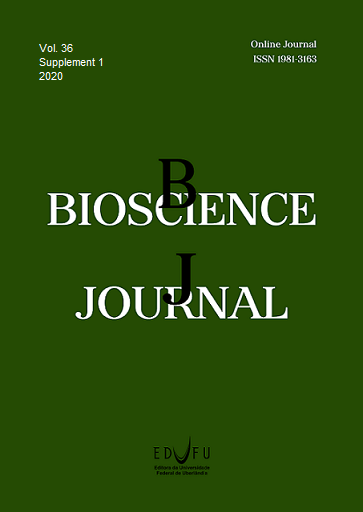Adjuvant interference on spray solution properties of 2,4-D and dicamba herbicides and their efficacy for Ipomoea SPP. control
DOI:
https://doi.org/10.14393/BJ-v36n0a2020-53578Palavras-chave:
Auxin, Morningglories, pH, Surface Tension.Resumo
Synthetic auxin herbicides constitute major alternatives for managing tough-to-kill weeds such as Ipomoea spp. Adjuvant use is known to positively affect the biological efficacy of pesticides by modifying key spraying solution and droplet properties. Determining to what extent the use of adjuvants could change spray solution parameters and affect synthetic auxin herbicides’ efficiency for Ipomoea spp. control were the research goals. The study was conducted in two phases: laboratory and field, respectively. In the laboratory, the pH, the surface tension, and the resources of the herbicide drops were measured. In the field, weed control was evaluated. All adjuvants modified spray solution properties, lowering surface tension values. Most adjuvants decreased pH values as well as number and density of droplets due to an increase in droplet size. Regardless of adjuvant usage, Ipomoea spp. control levels rose more rapidly following 2,4-D spraying rather than dicamba, resulting in lower biomass accumulation when the former was used. Dicamba-containing treatments displayed slightly but significantly lower Ipomoea spp. control levels at the end of the evaluation period. Herbicide efficacy for Ipomoea spp. control was not improved upon the addition to the spray solution of any of the tested adjuvants. Adjuvant use altered spraying solution and droplet properties. 2,4-D spraying allowed for lower Ipomoea spp. biomass and greater control levels relative to dicamba, suggesting it might constitute a better option for Ipomoea spp. control. Even though herbicide efficacy was not improved with adjuvants, their use should still be considered given favorable spraying solution alterations, mainly with some alteration in droplet sizes despite the use of similar spray nozzles tips - maintaining weed control efficacy.
Downloads
Downloads
Publicado
Como Citar
Edição
Seção
Licença
Copyright (c) 2020 Roberto Costa Avila Neto, Adriano Arrué Melo, André da Rosa Ulguim, Rafael Munhoz Pedroso, Geovana Facco Barbieri, Cassiano Salin Pigatto, Eric Fernandes Luchese

Este trabalho está licenciado sob uma licença Creative Commons Attribution 4.0 International License.






